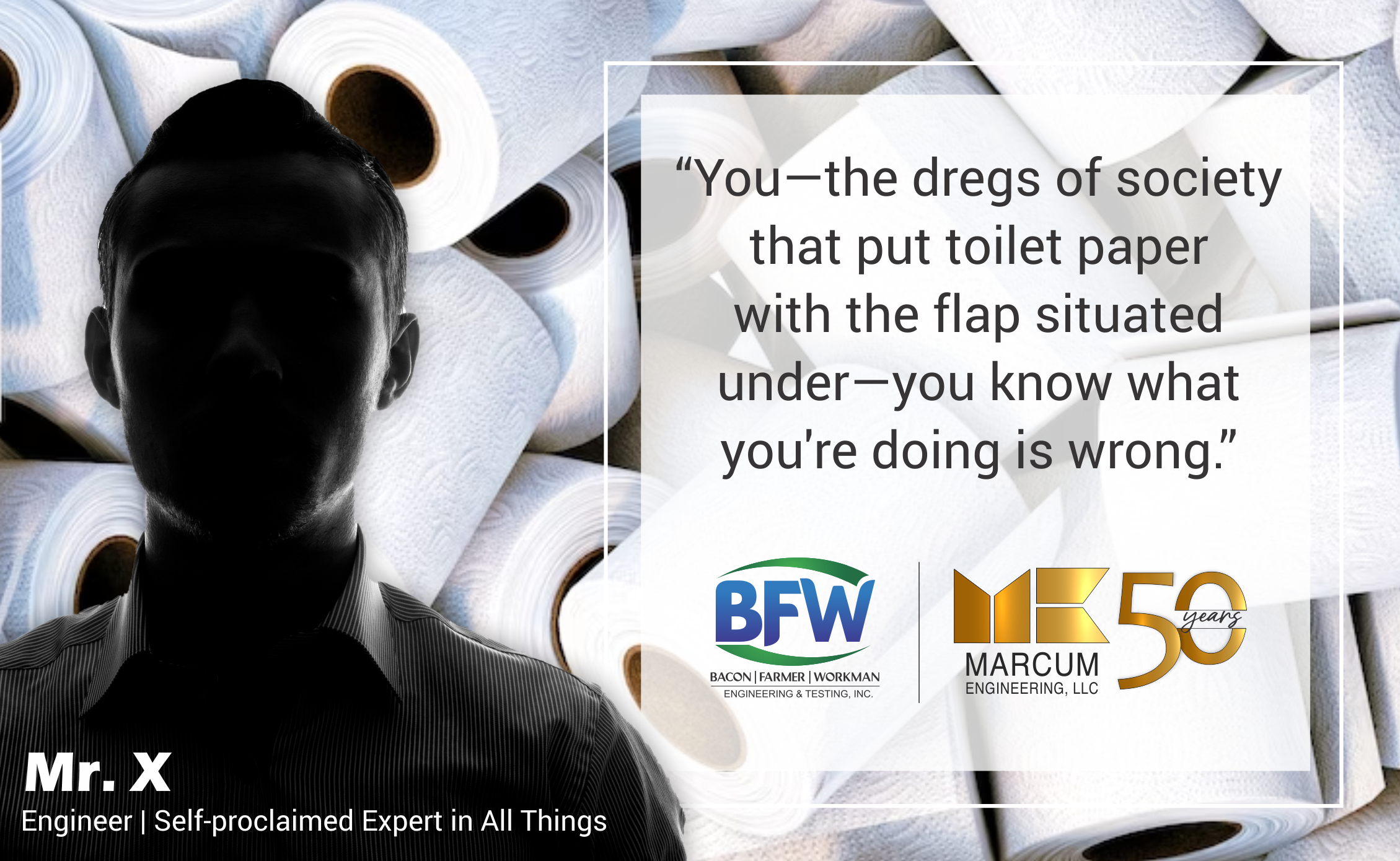At BFW/Marcum, we take pride in the cleanliness of our bathrooms. Sometimes you just need a cozy place away from your computer to sit and doom scroll TikToks on your phone, (stop doom scrolling, it’s only going to make things worse). That 5 or 10 minute of silence is precious.
While we keep a clean and well-stocked commode, we’ve never given much thought to the way in which the roll of toilet paper is installed. Some of us do it over, and some of us do it under.
That is until one of us entered the bathroom a few days back to find what we can only describe as an unhinged rant written on what we estimate is nearly 40 feet of toilet paper. There was only a moment of confusion (and some fear) before we got a good look at the penmanship, and, paired with the unorthodox delivery of said rant, knew immediately who the culprit was.
Our first instinct was to toss the paper away. However, our curiosity got the better of us. Curiosity then turned into self-righteousness—some of us knew that Mr. X was correct in all his assertions. Others? Let’s just say we are of two plies.
Who Engineered Toilet Paper?
I write this, dear reader, from the 2nd stall to the right. I must admit, I’ve gone through many revisions, nearly clogging our robust plumbing in the process. While I have no access to the time (I left my cell phone on my desk, thinking I’d be in and out), I fear I must be in the BFW/Marcum restroom for more than a day.
Before I dive into the over/under debate, I first want to introduce the idea of toilet paper. Like any engineer, I’m a fan of ideas—those notions that pop spontaneously into existence, things no mere layman may grasp. It’s us, the engineers, that translate those whimsies into the material.
The first engineered roll of toilet paper was invented by Joseph Gayetty of Massachusetts in 1857. You might ask what the average citizen used before the invention of common toilet paper. The answer, unfortunately, is whatever they could. Water, sand, corn husks, maybe an old shirt or two? Let’s just say that I’m happy to live with the heightened hygiene standards of the 21st century.
While toilet paper might feel akin to sliced bread in that it must have revolutionized the industry it was contained by, I must add it wasn’t until 1930 that splinter-free toilet paper was invented and manufactured. Let that sink in like a splinter in your behind.
Putting the Over/Under Debate to Rest
May I just break from the technical formalities for one moment? You—the dregs of society that put toilet paper with the flap situated under—you know what you’re doing is wrong. You must feel it in your bones—some kind of primitive instinctual whispering in your ear. Just look at it—flapping in the breeze of your bathroom like some kind of sad white flag of surrender.

Now that I’ve gotten that out of the way I have with me a list of highly technical reasons why OVER is the unequivocally correct way of placing your toilet paper roll.
1. Friction Coefficient: The coefficient of friction between the paper and the user’s hand is significantly lower when the paper is hanging over.
2. Tensile Strength: The tensile strength of the paper is optimized when it is hanging over, as the weight of the roll pulls the paper taut. This reduces the risk of tearing and provides a more consistent wipe.
We’ve all fallen victim to pulling off a ragged, possibly too-long length of toilet paper. Not only is it wasteful, but it could also very well ruin your plumbing.
3. Optimal Dispensing Angle: Studies have shown the optimal angle for dispensing toilet paper is between 10 and 15 degrees from horizontal, which is only achievable when the paper is hanging over. This ensures that the user can easily grab the paper and tear it off without awkward twisting or bending.
How do you explain to your peers that your carpal tunnel is not from your desk job, but from the terrible and unnatural way in which you hang your toilet paper?
4. Alignment Stability: When the paper is hanging over, the roll’s natural tendency is to unroll smoothly, reducing the risk of misalignment or uneven dispensing. This results in more efficient use of paper and less waste.
Tugging on a roll of toilet paper from below is akin to one of those magicians’ tricks—that one with the never-ending handkerchief. With no alignment stability, you’ll keep pulling and pulling at the toilet paper roll like some kind of mad toddler.
There’s More than One Way to Skin a Cat
This is an old phrase with even older origins. It means, in essence, that there’s more than one way to do something. However, I have an improved version; “There’s more than one way to skin a cat, however, doing so makes you either dumb or evil.”
Let’s just leave the cats alone, all right? To take it further, just because you can do something, doesn’t mean you should. Sure, the toilet paper roll will fit into the dispenser in either orientation. Also, you could balance it on your head, or eat the roll for lunch.
We’re engineers—we don’t do things just because. We don’t overwhelm ourselves with options. We use science and understanding to find the best solution for the situation. It’s our job to sift through the confusion of possibility to find the precision of certainty.
In other words, hang the roll over.

Recent Comments